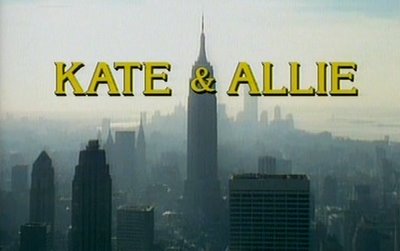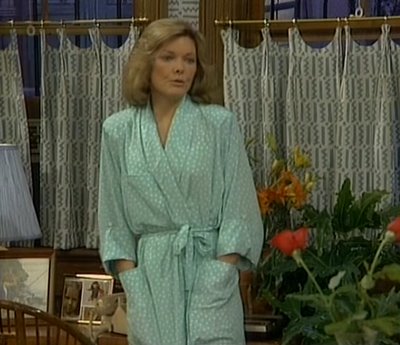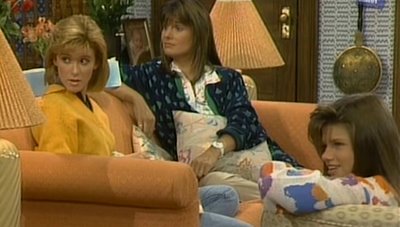 The notion of a second commercial TV channel had been around for at least a couple of decades. Finally, the Broadcasting Act 1980 set the wheels in motion to make that notion a reality.
The notion of a second commercial TV channel had been around for at least a couple of decades. Finally, the Broadcasting Act 1980 set the wheels in motion to make that notion a reality.
Looking tremendously cutting edge, Channel Four debuted on 2 November 1982 and it was a huge national event. We only had three telly channels back then, and BBC 2 was rarely watched in households round my way - we thought its content was far too highbrow about 99.9% of the time.
We feared Channel Four might be the same, but "gave it a go" anyway...
When I saw the colourful shapes whirling across the screen, I yelped: "Oh no - not another Rubik's puzzle!" I was just getting over being defeated by the Cube and bitten by the Snake...
 Thankfully, the shapes simply assembled themselves as Channel Four's logo. I breathed a sigh of relief - although I still thought that it had strong Rubikian (?!) influences!
Thankfully, the shapes simply assembled themselves as Channel Four's logo. I breathed a sigh of relief - although I still thought that it had strong Rubikian (?!) influences!
The logo was designed in 1982 by the Robinson Lambie-Nairn company.
Appraised of the facts about the new channel-to-be, Lambie-Nairn decided to play on the fact that Channel 4 would be buying all its programmes in, so would be a kind of patchwork.
The idea they came up with was to try and illustrate the various elements which would make up Channel 4 coming together.
With the logo created, Lambie Nairn used a computer to animate the outlines of the blocks to the final freeze. The movements were then hand coloured and shot, but it didn't work - what was lacking was shadow and lighting.
Lambie-Nairn went to Bo Gehring Aviation in Los Angeles, USA. The company specialised in computer animation and Lambie-Nairn ordered differing sequences of the same basic symbol to be made entirely on computer. At that time, nobody provided that service in the UK.
The result, of course, was the familiar Channel 4 logo seen on the opening night and for years afterwards - a very cutting edge design and animating technique in 1982.
But would Channel 4 be a cutting edge TV station?
From the Daily Mirror, 4/9/1982.Will ITV's Channel Four be a big turn-off?
You will soon be able to switch on to a brand new TV channel.
ITV's Channel Four goes on the air early in November.
But whether viewers will like what they see is another matter. The new channel is aiming to be experimental in content with a large output of educational and minority programmes.
In fact more like BBC-2 than ITV.
And in some quarters of the ITV companies fears are growing that this could be the recipe for a ratings disaster. For a start there'll be hardly any sport. What little there is will come mainly from America - basketball and grid-iron football, for instance.
Then each weekday night at the peak viewing time of seven, the channel plans an hour-long news programme.
Here's a run-down of what you will (or may not want to) be watching when Channel 4 flickers into life on Tuesday, November 2 at 4.45 pm.
COMEDY: From Australia, Paul Hogan. Top comedian Down Under and highly thought of by Channel 4 bosses who have bought twenty-six of his shows.
"The Optimist", a silent comedy starring up-and-coming English actor Enn Reitel and filmed in Hollywood.
And Peter Bowles stars in "The Irish RM", a six-parter based on the classic comedy stories of an Irish magistrate and set in the 1890s.
SOAP OPERA: "Brookside", an up-market "Coronation Street" set on an estate where most people own their own homes.
LIGHT ENTERTAINMENT: The Brazilian-made "Fantastico", reputedly one of the world's most spectacular song and dance shows, will run for twenty weeks at least.
NOSTALGIA: Hit American series of the Sixties such as "I Love Lucy", "The Munsters" and "Get Smart".
BLOCKBUSTER: "Nicholas Nickleby". The hit stage production of the Charles Dickens classic by the Royal Shakespeare Company.
FILMS: The silent version of "Napoleon", with a music track added, runs for six hours. Otherwise you'll be seeing golden oldies such as the 1930s gangster film "Scarface"; Eddie Cantor movies including "Whoopee".
Midnight movies on Friday and Saturday nights will run up to 2am, with a hint there will be some X-rated films.
DRAMA: Two plays ready for screening have down beat themes. "The Disappearance of Harry" stars Annette Crosbie as the wife of a man who leaves for work one morning and never returns. "Angel" is the story of a young saxophone player facing violence and death.
Channel 4's chief executive, Jeremy Isaacs, says: "it will be responsive to its audience's changing needs, lively, concerned, useful - and fun."
The target figure is a nightly audience of five million.
Will Channel 4 ever manage to attract that many viewers? Wait and see.
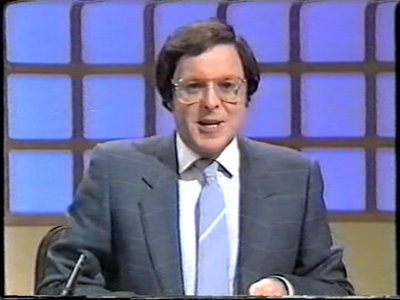 And so we waited. And we saw.
And so we waited. And we saw.
On 2 November 1982, after a welcome from presenter Paul Coia and a look at goodies to come, we settled back for the first of Channel Four's programmes - and it was "anyone for anagrams?" with Countdown.
You can see Richard Whiteley above and Carol Vorderman below as they appeared in the very first show.
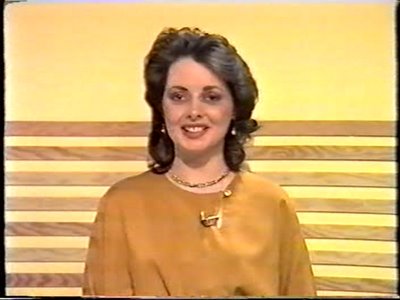 Early Channel 4 was short of adverts, due to an industrial dispute: should actors appearing in ads on channels like TV-am (which was due to start in February 1983) and Channel 4, both envisaged as attracting lower audiences than the main ITV regional channels, be paid less? It took some time to sort that one out, so, in the early days of Channel 4, we got to know pictures with captions like "Brookside follows shortly" very well indeed!
Early Channel 4 was short of adverts, due to an industrial dispute: should actors appearing in ads on channels like TV-am (which was due to start in February 1983) and Channel 4, both envisaged as attracting lower audiences than the main ITV regional channels, be paid less? It took some time to sort that one out, so, in the early days of Channel 4, we got to know pictures with captions like "Brookside follows shortly" very well indeed!
 The "Sun", January 20, 1983: TV critic Margaret Forwood comments on the lack of adverts and adds a few of her thoughts on Channel Four in general...
The "Sun", January 20, 1983: TV critic Margaret Forwood comments on the lack of adverts and adds a few of her thoughts on Channel Four in general...
 From the "Sun", February 2, 1982. Actually the provisional title for this show, which turned out to be "Brookside", was "Meadowcroft", not "Meadowcraft" and the creator was Phil Redmond not Redmund! Still, "Coronation Street" producer Bill Podmore's confident attitude is worth noting: "I enjoy competition... especially when we are going to win."
From the "Sun", February 2, 1982. Actually the provisional title for this show, which turned out to be "Brookside", was "Meadowcroft", not "Meadowcraft" and the creator was Phil Redmond not Redmund! Still, "Coronation Street" producer Bill Podmore's confident attitude is worth noting: "I enjoy competition... especially when we are going to win."
I remember watching the very first episode of Brookside and loving the electronic theme tune. But I wasn't too sure about the characters or setting. Would it take off? It all seemed a bit too real...
We couldn't have guessed on the first night, but with its gritty plots and set of real houses, Brookside would drag soap away from the cosy story lines, tight perms and brightly lit studio sets of Crossroads and Coronation Street, both fixtures on ITV since the 1960s, into the 1980s.
The characters - the moved-up-in the world Grant family, moved-down-in the world Collins family, and young urban professionals Roger and Heather Huntington, were uncompromisingly non-cosy. The language used in the early episodes was considered a little too real and had to be toned-down, but early Brookside, thought by many to be far too subversive to be a soap opera, was great. Well, OK, maybe this anti-Thatcher dog was a bit too darned shaggy. As a poor, working class geezer, I don't recall real life in the 1980s being anywhere near as grim as in Brookside, but for those of us who detested Thatcher at the time it was sheer bloody brilliance.
 Gordon Collins, played by Mark Burgess, was the first regular gay character in English TV soaps; Tracy Corkhill (Justine Kerrigan) got into trouble with telephone chatlines, parents, teachers, you name it; Annabelle Collins (Doreen Sloane) faced a move down in status from the leafy Wirral to rough and tumble Brookside; but for working class mum Sheila Grant, played by Sue Johnston, the Close marked a move up in the world from a grotty council estate.
Gordon Collins, played by Mark Burgess, was the first regular gay character in English TV soaps; Tracy Corkhill (Justine Kerrigan) got into trouble with telephone chatlines, parents, teachers, you name it; Annabelle Collins (Doreen Sloane) faced a move down in status from the leafy Wirral to rough and tumble Brookside; but for working class mum Sheila Grant, played by Sue Johnston, the Close marked a move up in the world from a grotty council estate.
I believe that Brookside was, at least partly, responsible for some new (to most of us) slang words over the next few years. Before the 1980s, I recall nobody in my area calling Christmas "Chrimbo" and electricity "'leccy", but, post November 1982, both gradually seeped into usage.
They seemed to originate from Brookside "Scouse speak".
Sainsbury's, of course, became "Sainsboe's"!
Brookside was soon more commonly known as "Brookie", and Coronation Street became "Corrie", which, again, I don't recall before the 1980s. Soaps simply weren't trendy enough before the 80s to bother with zippy abbreviations. Brookside influenced other soaps and helped to blast away soap's fuddy-duddy image - making it respectable for youngsters to tune in.
But I digress. Back to what I viewed on that first night on Channel Four...
I remember being depressed by the opening night film - Walter - about a man with "learning disabilities" (the modern day PC phrase - not in use round my way, nor I believe anywhere else, in 1982!) who was subjected to various horrible experiences after his mother died.
Five Go Mad In Dorset was a Comic Strip Presents production, and a merciless mickey take of the Enid Blyton Famous Five books.
The show had a "surprise guest star" - Ronald Allen, David Hunter of Crossroads fame - appearing as Uncle Quentin. Dear Uncle told the children: "I'm a screaming homosexual, you little prigs!"
It was difficult not to see Ronald Allen as his Crossroads character, I don't think I'd ever seen the actor appearing in any other show before, and to hear "David Hunter" coming out with those words left me absolutely breathless with laughter.
At the end of my first taste of Channel Four programmes, I decided that it was different. Definitely different. And worth another look...
See a 1988 article on Channel Four favourite Treasure Hunt here.
----------------------------------------------------------------------------------

 From
the "Sun", February 2, 1982. Actually the provisional title for this
show, which turned out to be "Brookside", was "Meadowcroft", not
"Meadowcraft" and the creator was Phil Redmond not Redmund! Still,
"Coronation Street" producer Bill Podmore's confident attitude is worth
noting: "I enjoy competition... especially when we are going to win."
From
the "Sun", February 2, 1982. Actually the provisional title for this
show, which turned out to be "Brookside", was "Meadowcroft", not
"Meadowcraft" and the creator was Phil Redmond not Redmund! Still,
"Coronation Street" producer Bill Podmore's confident attitude is worth
noting: "I enjoy competition... especially when we are going to win."












